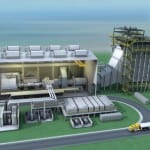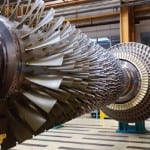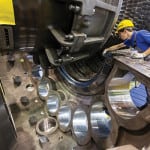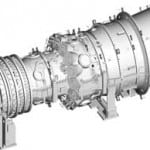Competition among gas turbine makers heated up this September as Alstom unveiled its upgraded GT24 gas turbine and corresponding 60 Hz KA24 combined cycle power plant, while Mitsubishi Heavy Industries (MHI) introduced the M701F5 gas turbine—a 50 Hz F-class gas turbine upgrade.
An Upgraded GT24
Alstom’s upgraded product launches came on the heels of its upgraded GT26 gas turbine and corresponding KA26 combined cycle power plant for the 50 Hz electricity markets in June. The French company introduced the original GT24 gas turbine 15 years ago, and even in the early days it was recognized for “exceptional operational flexibility, high part-load efficiency, and fast start-up capabilities,” Alstom says in a technical paper. “From the very beginning this gas turbine technology incorporated features such as multiple variable compressor guide vanes and sequential combustion, which set a new industry standard regarding operational flexibility.”
The upgraded turbines were designed around a heightened need for high operational flexibility, a trend that is expected to continue. “While demand will continue to vary greatly, the growing portion of renewable sources of electricity production are expected to require combined cycle plants to be more and more used to levelize the overall production of electricity in many power markets,” the technical paper says.
Just five years ago, combined-cycle power plant specification requirements focused on the highest baseload efficiency based on about 8,000 operating hours per year and the lowest specific sales price. Today’s combined cycle power plant must be based on the highest overall weighted efficiency based on expected operating hours and load regime, and the lowest cost of electricity based on both baseload and part-load profiles.
The next-generation GT24 is capable of delivering 230 MW at 40% efficiency (with a heat rate of 8,571 Btu/kWh), the company claims. The KA24 combined cycle plant can achieve 700 MW output in a 2 x 1 configuration, and when fully optimized, it achieves more than 60% gross efficiency. The plant also features a spinning reserve for delivering more than an additional 450 MW in 10 minutes in low-load to baseload settings. The full upgrade package has been implemented in the grid-connected GT26 Test Power Plant in Birr, Switzerland (Figure 1). Alstom plans to manufacture key plant components of the upgraded gas turbine at its factory in Chattanooga, Tenn.
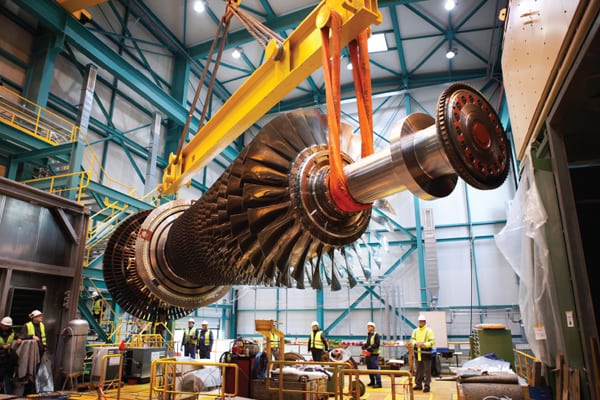 |
| 1. A notch above. Alstom in September launched an upgraded GT24 gas turbine and corresponding KA24 combined cycle power plant for 60 Hz electricity markets. The turbine was tested at Alstom’s grid-connected GT26 Test Power Plant in Birr, Switzerland. Courtesy: Alstom |
A New Generation F-Class Turbine
Later in September, MHI announced its own newly upgraded and more flexible gas turbine design. The F-class M701F5 will operate at a turbine inlet temperature of 1,500C—a level only reached by G-class or higher turbines, MHI said.
The M701F5 gas turbine achieves a rated simple cycle power output of near 350 MW (ISO basis) and 520 MW in combined cycle power generation. It is designed around the preceding M701F4 and leverages experience with MHI’s F-class fleet, which has 182 units in operation around the globe, with more than 7 million actual operating hours.
The compressor section retains the M701F4’s airflow, but mid- and rear-stage profiles have been modified from NACA1 to CDA2. MHI also said that the combustion system is based on the verified GAC engine, and the turbine section incorporates turbine technologies developed for the J Class, including advanced cooling technology and advanced thermal barrier coatings.
Small But Flexible Turbine
Also in September, GE launched its FlexAero LM6000-PH (Figure 2), a highly efficient 50-MW gas turbine that couples flexibility and efficiency, reaches full power in just five minutes, and uses no water. GE—which introduced the 510-MW FlexEfficiency 50 Combined Cycle Power Plant in May (see “GE Develops FlexEfficiency 50 for Increased Operational Flexibility,” p. 90) and claims it has already received more than $1 billion in orders for its aeroderivative and heavy-duty gas turbines this year—also said the FlexAero was launched to meet fast-changing power generation needs.
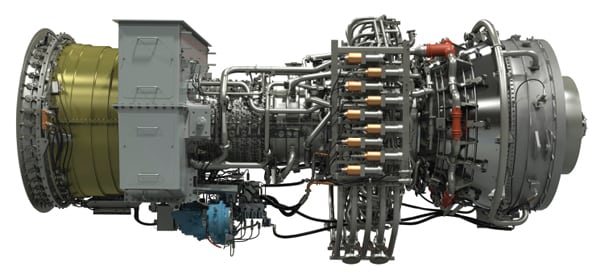 |
| 2. Light and lithe. Following the launch of its 510-MW FlexEfficiency 50 Combined Cycle Power Plant in May, GE in September added the 50-MW FlexAero LM6000-PH to its FlexEfficiency portfolio. Courtesy: GE |
The company’s customer base has rapidly changed and expanded to include industrial businesses and remote communities, Darryl Wilson, president and CEO of GE’s aeroderivative gas turbine business said. “We developed the FlexAero to give those customers advanced technology, leading in flexibility and efficiency, which can be shipped and installed faster than any technology in its class and can operate independent from the power grid.”
GE additionally claims that the turbine, operating in a combined cycle, can reach an efficiency above 80% through cogeneration.
A key feature of the turbine is that it uses GE’s innovative DLE2.0 technology, which reduces NOx emissions to just 15 ppm without the need for water. The technology allows customers to save more than 26 million gallons of water per turbine, per year, which is typically used to dilute CO and NOx emissions in a gas turbine, GE said.
“Today, 30 percent of the world’s population is water constrained. By 2025, the number will reach 60 percent,” said Steve Bolze, president and CEO of GE Power & Water. “As global energy demand increases, so does the stress on our water supply—a reality that we take very seriously when we develop new technologies across our portfolio.”
–Sonal Patel is POWER’s senior writer







